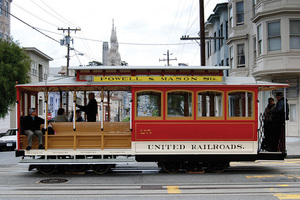
Will you look this good at 118? This Powell Street cable car (at least part of it) has been riding the rails since 1890. On May 28, it returned to service in the flamboyant livery it wore at the time of the 1906 earthquake and fire. Neither of the landmarks it shares the frame with — Coit Tower (1933) and Sts. Peter & Paul Church (1924) — go back that far. Rick Laubscher photo.
On a crisp May morning on Mason Street, heads suddenly swiveled along the sidewalks as a vision in red rumbled by. It was a vision not seen here for more than a century, and Muni’s latest recognition of its heritage.
It was Powell cable car No. 25, gloriously rebuilt and resplendent in its ‘new’ livery, which actually represents a faithful-as-possible re-creation of the paint scheme it wore at the time of the 1906 earthquake and fire, when the Powell lines were owned and operated by United Railroads.
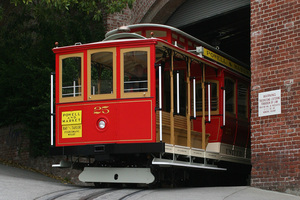
David Dugan photo.
The car pulled out from the Washington-Mason car barn at 9:30am, under the expert hand of gripman Al Chang. It ran smoothly to Bay & Taylor on the Powell-Mason line that is virtually unchanged since its opening 120 years ago. After that first revenue run, Chang pronounced the car “a good runner,” but noted it will be even better once its new trucks loosen up a little. On subsequent runs, it drew extra attention from riders and onlookers for its elegant paint scheme and, well, brightness. There hasn’t been a true red cable car on the streets of San Francisco since Teddy Roosevelt was president.
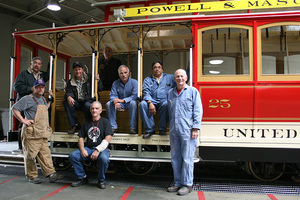
Muni cable car craftsworkers pose proudly in front of their handiwork. Top row, from left: Tony Gonzales, conductor; Bob Harris, carpenter supervisor; Al Chang, gripman; Larry Harris, painter; Efren Bernel, painter. Bottom row, from left: Mark Sobichevski, carpenter; John Barberini, carpenter; Ken Russi, painter. David Dugan photo.
The car itself is a testimony to the enduring skill and dedication of Muni craftsworkers. Originally built in 1890 for the Ferries & Cliff House Railway as part of a contract given to Mahoney Brothers of San Francisco, the car originally served the Sacramento and Clay Streets line, which at that time ran from the Ferry Building to Walnut Street. It was identical to cars used on the two lines running on Powell Street at that time: Powell-Mason and Powell-Jackson (later known as Washington-Jackson, which evolved into the Powell-Hyde line in 1957).
In 1893, the Ferries & Cliff House Railway was absorbed by the Market Street Railway Co., one of several so-named companies from which our nonprofit organization takes its name. The cable cars of the 1890s Market Street Railway Co. were painted in different colors by line. For example, Powell-Mason cars were predominantly yellow, Powell-Jackson and Sacramento-Jackson green, and Sacramento-Clay red. This company also renumbered the cars to avoid conflicts between different lines’ fleets. Car No. 25 thus became No. 525.
In 1902, further consolidation of the city’s privately owned transit systems led to the creation of United Railroads. That company recognized that its operating flexibility was impeded by having dedicated streetcar and cable car fleets for each line, so they began painting cars in a standard livery — red bodies with cream trim — and switching them between lines as needed.
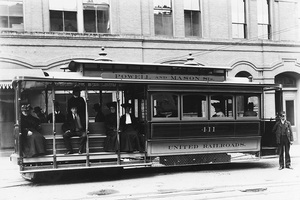
San Francisco Municipal Railway photo.
That red and cream is what car No. 25 and the rest of the narrow-gauge cable car fleet wore on April 18, 1906, when the entire Powell Street fleet was incinerated inside the Washington-Mason car barn in the conflagration that followed the great earthquake. However, 24 cable cars stored outside the fire zone on Sacramento Street survived, including car No. 25. These cars were reassigned to the Powell lines when the cable machinery was replaced and the tracks repaired in 1907.
Around this time, car No. 25 and its siblings received a new United Railroads paint scheme: green with red trim (similar to that worn today by cable car No. 13). According to historian Emiliano Echeverria, the color change was inspired by a group of 50 new streetcars built for Chicago and wearing its dark green livery that were diverted to San Francisco as an earthquake relief measure. The United Railroads bosses apparently liked the green better than their own red and began converting their surviving vehicles to match.
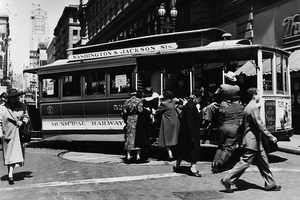
San Francisco Municipal Railway photo.
Green became the scheme for most of the century. The green livery for cable cars and other transit vehicles was embraced by United Railroads’ successor, (another) Market Street Railway Co. in 1921, and then again by Muni after it took over the Market Street Railway Co. in 1944. Like the other Powell cable cars, No. 25 went through a series of repaintings in different but mostly green combinations until it, with almost all the rest of the Powell cars, was painted in a simplified version of the original Ferries & Cliff House Railway livery — predominantly maroon with white ends and light blue and buff trim — during the rebuilding of the system in 1982-84.
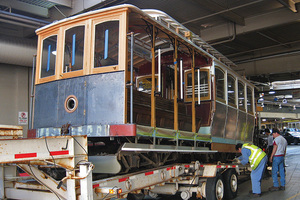
Val Lupiz photo.
Along the way, car No. 25 itself was extensively rebuilt by Muni craftsworkers in 1976. Then, over the past two years, it was even more extensively rebuilt, receiving an entirely new roof, ends, and sides. Very little now remains of the original 1890 No. 25, but the resulting car is probably better crafted than the original, with tight joints, metal reinforcements in critical areas (the results of decades of engineering and construction improvements), and the realization of today’s craftsmen that they are working on a national treasure, rather than just another transit line, which was the case in 1888.
Car 15: But wait, there’s more!
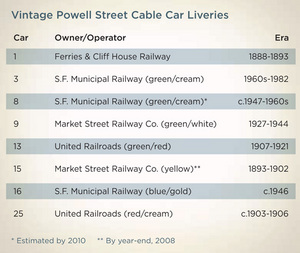
Click to enlarge.
The vintage livery on car No. 25 came from Market Street Railway’s suggestion to Muni that the vintage Powell liveries already on the street be expanded (see table) by painting No. 25 in the 1906-era colors. At the same time, Market Street Railway suggested that Powell car No. 15, a brand new creation of the cable car carpentry shop (replacing a worn-out and retired car of the same number) be painted in the 1890s Powell-Mason livery of yellow with cream and buff trim and a red roof. Muni agreed, and Market Street Railway — with research help from Emiliano Echeverria — contributed reference illustrations and reproduced the side panel lettering decals for the two cars.
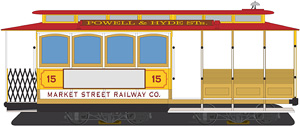
Work will soon begin on painting car No. 15, along with final mechanical work. That car, resplendent in yellow, could be on the streets late this year.
Cars No. 15 and 25 almost complete the array of vintage liveries that have graced Powell Street cable cars over the past 120 years. One rather glaring omission remains, however: the first universally-applied Muni cable car livery, green and cream with the bold and simple Municipal Railway in elegant black letters on cream in the traditional ‘owner’s panel’ at the bottom of the car’s sides.
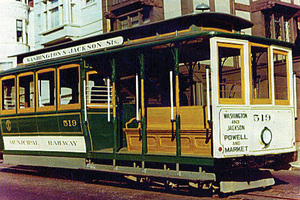
That’s the livery that graced the Powell fleet in 1947, when Mayor Roger Lapham tried to kill Muni’s cable car operation and replace it with buses. (Market Street Railway volunteers have cosmetically restored one of the buses purchased — but fortunately never used — for that purpose.)
Market Street Railway has requested that Powell car No. 8, now being rebuilt at the carpentry shop, receive that historic livery, and we are delighted to report that Muni has enthusiastically agreed. That car should reach the streets in 2010 or 2011, in good time for Muni’s centennial in 2012.
Market Street Railway believes the addition of more vintage Powell Street liveries is a fitting tribute to the evolving, continuing saga of San Francisco’s cable cars, making them even more ‘museums in motion’.
Two red cars in one day–I’m probably not the only Pacific Electric fan who thinks a red cable car is “cool”.
Here’s a question for the folks who have a “firm grip” on cable car history: Back in 1973 my daughters and I came “up north” to see the Cable Car Centennial. We even got up at “O-dark-30” to watch #8 descend Clay St. hill (with the help of a flat bed truck) to the accompaniment of bagpipes honoring Mr Hallidie’s Scottish heritage. Later that day we toured Elkton Shops, and I photographed the girls next to a cable car underframe. Someone had chalked on the ironwork: “A new cable car/watch it grow” (not sure if that’s the exact quote). And now for the question–What cable car would have just started construction (or rebuilding) in Aug. 1973? I checked some Muni history books, but the data weren’t quite clear.